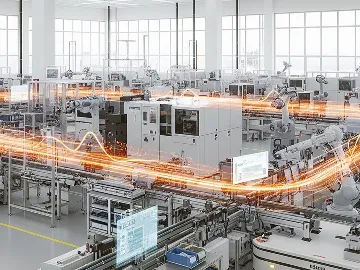The success of the logistics and supply chain operations often depends on how well the company manages its inventory, collaborates with the suppliers, and forecasts demand. It pushes businesses to integrate various tools to streamline inventory management and improve efficiency.
According to Fortune Business Insights, the global inventory management software market, valued at $2.13B in 2023, is expected to grow from $2.31B in 2024 to $4.84B by 2032. Companies also integrate various technologies into their existing systems, and the Internet of Things (IoT) stands out.
This article reviews the use cases of IoT in inventory management, the benefits this technology can bring, and the challenges the companies may encounter during its adoption. It also provides tips on how to navigate these complexities and what N-iX can do to help you streamline integration.
How IoT is used in inventory management
For businesses, inventory can be anything they must restock to ensure their operations. For example, for car manufacturers inventory can range from the parts they buy from suppliers to the equipment and tools they use to assemble the cars to the cars as finished products.
Effective inventory management relies on accurate data regarding the amount, location, movement, and environmental conditions of raw materials, components, and finished products. Acting on this data helps businesses prevent stockouts and overstocking, manage supply and demand, set reorder points, and track stock location and condition within warehouses.
Modern IoT solutions allow businesses to monitor the relevant data and make informed decisions on inventory management. Here are a few use cases of what IoT technologies in inventory management may enable.

Real-time item location tracking
IoT-enabled RFID tags or GPS trackers, attached to inventory items, allow businesses to monitor the real-time location of assets across warehouses or during transit (including effective fleet magement). This way, the businesses can track items, update inventory levels, and manage order fulfillment more efficiently.
Environmental monitoring and smart metering
In industries like food and pharmaceuticals, IoT sensors monitor conditions such as temperature and humidity. For example, IoT temperature sensors can track perishable goods, ensuring conditions remain within ideal ranges. This function is critical to setting up automatic alerts to notify managers of environmental deviations so they can intervene faster and prevent item spoilage.
IoT also allows for real-time energy and resource consumption monitoring within warehouses and production facilities. IoT-enabled smart meters track usage patterns, helping businesses optimize energy costs. These meters also support automated alerts for replenishing essential resources, preventing disruptions in operations.
Data collection for inventory forecasting
IoT devices collect and send data on product movement and customer demand patterns. It can later be used to predict inventory needs and adjust supply levels accordingly. Businesses can use data analytics and IoT to optimize their inventory levels based on real-time sales data and seasonal demand.
Replenishment automation
IoT technologies enable automated inventory updates by tracking product movement on retail shelves, helping businesses achieve better stock visibility. Smart shelves equipped with weight sensors and RFID can detect when the item amount or quantity is below the established threshold and notify employees when it's best to start replenishment.
Explore further: Automation in inventory management: Case studies and hot trends
Data collection for delivery route and warehouse optimization
IoT devices are used to track and help manage item locations within warehouses, optimize picking routes, and improve inventory accuracy. Companies can also connect IoT-enabled robotics and smart shelves, which help with faster item picking, reducing search times and labor costs.
Indoor navigation
IoT enables precise indoor navigation in inventory management by using sensors, beacons, and RFID tags to track item locations in real-time. This tech helps staff quickly find items, reduces search time, and optimizes order fulfillment.
Setting up indoor navigation with IoT for inventory management requires location sensors like BLE beacons or RFID tags, mapping software to visualize the space, and a reliable network (Wi-Fi or mesh) to transmit data. They also need an IoT platform that integrates with inventory systems for real-time updates and mobile devices or AR for efficient item location. This setup enables quick, accurate inventory tracking, streamlining order fulfillment and boosting efficiency.
These were just a few popular uses of the Internet of Things in inventory management. However, the full potential of this technology for a specific business can only be realized after thorough research and discovery by a knowledgeable team. Let's review what it takes to make IoT-based inventory management solutions work.
Read more: Inventory management software development: Extensive guide
What do businesses need to build an IoT-based inventory management solution?
Businesses need several components to create a robust IoT-enabled inventory management system. Below, we break them down by their categories, component examples, and functions.
|
Category |
Component example |
Functions |
|
Hardware |
|
Sensors and cameras collect data on temperature, humidity, weight, image, location, etc. |
|
Connectivity and network |
|
Networks ensure the successful transmission of data collected by hardware and send it to the central platform. |
|
Cloud storage for data analytics |
|
Cloud storage keeps the collected data and functions as a platform to enable various technologies to process and analyze it (computer vision, AI, ML, etc.) |
|
Software |
|
Various types of software that visualize the data, perform analytics, turn the results into actionable insights, and protect IoT inventory management systems from data breaches and unauthorized access |
Your choice of components for the IoT inventory management solution will depend on various things, including the type of inventory. Usually, there are four types of inventory:
- Raw materials and components: Items that the finished product is made of. In the automotive example, it will be steel, utilities, car parts, etc.
- Work-in-Progress (WIP): Partially completed goods that are still in production (e.g., partially assembled cars on the production lines). It also includes labor and production costs.
- Finished goods: Items ready for further distribution. In the automotive industry, it will be fully assembled, ready-to-use cars.
- Maintenance, repair, and operating supplies (MRO): All supporting materials used for manufacturing items but not part of finished products. For automotive, it would be equipment, tools, oils, equipment replacement parts, cleaning supplies to service plant machinery, etc.
Each inventory type may require a different set of sensor devices, networks, and tech infrastructure to maximize the potential of IoT technology within a specific environment. Here are a few advantages to expect if set up correctly.
Benefits of IoT in inventory management
Inventory management is an essential operation in supply chain and logistics, and its success relies on the business's ability to track, locate, and maintain the optimal amount of items. It also helps businesses make sure the customers can find what they need and purchase it, increasing revenue.
According to Eseye's 2024 State of IoT Adoption Report, 74% of supply chain and logistics businesses attribute their revenue increase to IoT implementation, as it allows them to streamline their operations. Let's review the benefits IoT can bring when adopted for inventory management.

Enhanced accuracy and access to inventory data
IoT sensors and RFID tags allow for precise, real-time updates on stock levels across various inventory types. It allows businesses to maintain accurate inventory records, which is critical for high-value items or perishable goods in the healthcare and food industries.
Automated stock management and replenishment
IoT-enabled inventory management tools also enable automated monitoring of inventory levels, triggering reorder notifications when stock is below the set threshold. This benefit is especially useful for finished goods and raw materials inventory as it ensures that production and supply lines remain uninterrupted. As a result, the manufacturers and retailers avoid stockouts and production delays.
Optimized storage conditions
IoT sensors can monitor environmental conditions (e.g., temperature, humidity) in real-time at the warehouse, production sites, and shops. This step is essential for managing sensitive items like pharmaceuticals, food, or electronics. Maintaining the proper storage conditions helps ensure product quality, extend shelf life, and comply with safety regulations.
Reduced operational costs
Since IoT solutions can automate stocking and data entry, they allow businesses to reduce labor costs associated with these tasks. It is beneficial for managing components in large warehouses or distribution centers, where IoT-enabled robots and drones can handle item counts and shelf restocking. In addition, it can help reduce human errors and avoid associated bottlenecks.
More accurate demand planning
IoT in stock management provides valuable data on product sales, behavior patterns, and inventory turnover rates. This data can be later used by an ML-powered demand-planning solution, allowing companies to drive more insights for accurate demand forecasts. As a result, it improves resource allocation and reduces excess inventory, benefiting finished goods and seasonal stock management.
Better collaboration across the supply chain
Effective collaboration across the supply chain is based on timely data on item condition, amount, movement, etc. IoT allows businesses and stakeholders to monitor the specific parameters of the inventory data in real time to ensure end-to-end supply chain visibility. This transparency helps optimize shipping routes, monitor in-transit goods, and track order fulfillment, vital for work-in-progress items and high-value goods. Moreover, it helps businesses adjust their processes when they spot the disruption, allowing them to stay flexible.
More on the topic: IoT in the supply chain: Success stories and tips
Enhanced service speed and workflow optimization
Internet of Things technologies applied in inventory management help warehouse workers and suppliers locate the precise location of the necessary items and pallets. It allows the employees to reduce the loading and unloading times, avoid misshipping, and optimize indoor and outdoor navigation.
Enabled further transformation
With adopted IoT solutions, businesses can plan further transportation and automation of processes, reducing manual labor. For example, an IoT-based indoor navigation system will help companies adopt automated guided vehicles (AGVs) for inventory transportation within manufacturing or warehouse facilities. It can also enable robot-assisted parcel handling and automated order fulfillment.
Achieving these benefits will allow companies to redefine their inventory management, increase transparency across the supply chain, and allure new clients into collaboration. However, there are a few things a company should consider when adopting IoT technologies.
Read on: How IoT in retail industry helps businesses evolve
Challenges of IoT in inventory management adoption
From handling vast amounts of data to ensuring device compatibility across various systems, implementing IoT in inventory management can be complex. Let's explore the possible challenges and how businesses can effectively tackle them.

Data overload and management
IoT devices generate plenty of real-time data, which can overwhelm inventory management systems if not handled effectively. Processing, analyzing, and storing this data can require significant resources, and a lack of efficient data management can result in missed insights and erroneous decisions.
In addition, if the incoming data is over the volume that the system can process, it may result in system slowdown, data loss, and network bandwidth congestion, causing operational delays.
N-iX solution: Implement scalable cloud storage solutions and use data management platforms to efficiently process, filter, and analyze real-time data. It will help you adjust processing capabilities whenever necessary. You should also consider adopting edge computing to handle processing closer to data sources, alleviating network and central system strain. Moreover, AI-driven analytics will help you to interpret large datasets for actionable insights, enabling real-time decision-making without overwhelming systems.
Device compatibility and interoperability
The IoT devices come from various vendors, requiring different approaches to integrate with existing inventory management systems to communicate effectively. Such incompatibility can disrupt data collection, making a unified view of inventory challenging.
N-iX solution: Prioritize adopting standards-based protocols, such as MQTT, CoAP, or OPC UA, which enable seamless data exchange across different devices. In addition, middleware solutions can further streamline integration by acting as a bridge, translating data formats and communication protocols to ensure all devices connect effectively. Moreover, working with IoT vendors that offer API-compatible devices and software will reduce integration complexities and foster a unified view of inventory data.
Network connectivity
For IoT inventory management tools to be effective, they require stable network connectivity. As the Eseye 2024 State of IoT Adoption Report states, for 22% of IoT solution adopters, the main challenge is to enable uninterrupted global connectivity. Regarding inventory management, issues such as dead zones in large warehouses, interruptions in wireless networks, or poor internet infrastructure can lead to data gaps and delays, impacting real-time tracking.
N-iX solution: Implement mesh networks or cellular IoT solutions that provide consistent coverage, especially in large facilities with potential dead zones or remote warehouse areas. Conducting a thorough network assessment beforehand can help identify areas with weak signals, allowing for strategic placement of additional access points or signal boosters. Additionally, hybrid connectivity solutions-such as combining Wi-Fi with LTE or 5G-can provide backup options to maintain uninterrupted data flow.
Related: How reliable connectivity solutions define the future of IoT-powered smart manufacturing
Security and privacy risks
According to the Eseye 2024 State of IoT Adoption Report, cybersecurity has been a major focus of IoT adopters for four consecutive years-and for a reason.
IoT devices and inventory data are vulnerable to cyberattacks, and the more devices, the more opportunities for breaches and unauthorized access. As IoT devices track sensitive information about stock levels, locations, and movement, data breaches can result in significant losses, operational disruptions, and compromised customer data.
N-iX solution: Strengthen IoT security by adopting a layered cybersecurity approach. Implement encryption protocols for data storage and transmission, ensuring that even if data is intercepted, it remains unreadable. Use network segmentation to isolate IoT devices and conduct regular security audits. For sensitive data, employ data anonymization to comply with privacy regulations while safeguarding customer information. Moreover, regular device firmware updates and patch management also help detect potential vulnerabilities in IoT devices. You should also ensure access controls and multi-factor authentication (MFA) to safeguard sensitive data and limit access to authorized personnel only.
Battery life and device maintenance
Some IoT sensors, devices, or tags rely on batteries, which need regular monitoring and replacement. If you have a lot of battery-based devices located across the production site or warehouse, their management may become time and resource-consuming. Poor battery management or device malfunctions can lead to inaccurate inventory tracking or data loss, increasing operational costs and management complexity. Moreover, as the Eseye report states, up to 58% of IoT projects fail because of issues at the device level.
N-iX solution: Choose energy-efficient IoT devices with longer battery life, or leverage energy-harvesting technology when possible. Implement predictive maintenance powered by IoT analytics to monitor device health, allowing you to anticipate when batteries need replacement or devices require servicing. For large-scale IoT systems, explore renewable power options like solar charging to reduce dependency on frequent battery replacements. You can also establish a centralized device management system to manage, monitor, and troubleshoot devices across large areas.
Industry-specific challenges
Inventory management across business verticals has its specifics, and the same IoT solution may not work for a fashion retail store and a car manufacturing site. While the cost of IoT devices decreases, adopting the Internet of Things in inventory management will require a lot of investment, and miscalculating the solution's design, use, and performance may compromise the project's success.
N-iX solution: We recommend you tailor IoT solutions to your unique operational needs and environments. To do so, you should conduct a thorough requirements analysis upfront to help align technology choices with industry-specific demands and ensure that the solution will serve the forecasted dynamics over the years. If you already have a solution, revisit the IoT setup regularly to optimize it for evolving requirements. Another option is to consult with IoT implementation companies like N-iX that are experienced in adopting IoT in a target sector.
You can mitigate these challenges before the project starts if you have a reliable tech partner like N-iX. Here's what we can do for you.
Revolutionize manufacturing with IoT – unlock its value for the industry in the guide!


Success!

How N-iX can help you adopt IoT for inventory management
Over the past 23 years on the global market serving international businesses across Europe and the Americas, N-iX has expanded its IoT expertise in various domains. We have developed custom IoT solutions for businesses from manufacturing, logistics and supply chain, energy management, retail, healthcare, and other industries. Here's what we offer in terms of IoT for inventory management.

Custom IoT solution design and development
N-iX assists in creating end-to-end IoT solutions that integrate seamlessly with existing inventory systems. This service includes solution architecture, hardware, middleware, and software design to ensure interoperability with other systems critical for inventory visibility and control.
IoT hardware design
Our team designs and develops hardware prototypes, ensuring they meet performance and reliability standards. This is especially useful for custom solutions tailored for specific locations and infrastructures.
Custom dashboard and UI/UX development
N-iX designs intuitive dashboards that display real-time data from IoT devices, allowing inventory managers to track stock levels, monitor conditions, and receive alerts for critical updates. Our UI/UX design supports customization, helping you navigate complex data and make event-based decisions.
IoT sensors and device integration
Our IoT sensor and device integration services include tailored sensor selection and protocol support (e.g., MQTT, CoAP, Zigbee, Bluetooth). We help establish seamless connectivity with cloud platforms like AWS, Azure, and GCP for real-time data management. N-iX also covers edge computing, data processing, and rigorous testing to ensure accurate, efficient, and reliable IoT performance.
IoT network setup
N-iX helps with network architecture design, connectivity optimization, and configuration for reliable data transfer across complex environments. Our team ensures stable, secure connections using protocols like Wi-Fi, LTE, LoRaWAN, and 5G, tailored to meet the specific demands of your IoT infrastructure. Moreover, we help clients implement mesh networks to avoid dead zones, data loss, and process interruptions. We also address network scalability, minimizing latency and ensuring real-time data flow for effective inventory management, asset tracking, and other IoT applications.
AI-powered data analytic solution development
Our team designs advanced data analytics frameworks that integrate seamlessly with IoT systems, leveraging AI, ML, and predictive analytics to enhance forecasting and optimize stock levels. We also build custom real-time monitoring dashboards and IoT data visualization tools for inventory managers to address stock shortages, prevent overstocking, and streamline operations.
Cloud integration and data management
N-iX offers various cloud solutions to manage ever-growing data generated by IoT sensors. By integrating with cloud providers like AWS, Azure, and Google Cloud, N-iX ensures scalable data storage, real-time analytics, and secure access to inventory information across locations.
With over 200 experts on board and various tech partnerships, you can choose the most optimal cooperation model for your IoT project in inventory management. Contact our team if you have a ready-to-follow plan or want to know what difference IoT can make. Let's discuss how modern technologies and market experience can help you streamline inventory operations and make your business more flexible!
Have a question?
Speak to an expert




